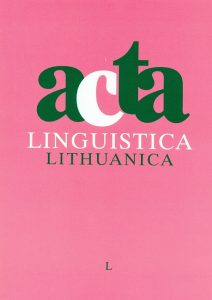Naujas požiūris į lietuvių kalbos daiktavardžio linksniavimo tipus pagal natūraliosios morfologijos teoriją
A new look at the declensional classes of the Lithuanian noun in the framework of natural morphology
Author(s): Asta Kazlauskienė, Laura Kamandulytė-Merfeldienė, Ineta SavickienėSubject(s): Language and Literature Studies
Published by: Lietuvių Kalbos Institutas
Keywords: Lithuanian; declension types; natural mophology
Summary/Abstract: In this study, a new classification of noun classes is intoduced, based on Dressler’s concepts and on definitions advanced within the framework of natural morphology. It involves a hierarchical organisation of noun classes comprising the levels of microclass, subsubclass, subclass, class and macroclass. A paradigm comprises all inflectional forms of one word. An isolated paradigm is a paradigm which differs morphologically or morphonologically from all other paradigms. A thematic marker is the inflectional marker of an inflectional class. A class is a set of paradigms. It comprises subclasses which differ only in morphonological details. It is established by a common thematic marker. We differentiate hierarchically: macroclass and its successive subset classes: class, (sub)subclass, microclass. A microclass is the smallest subset of an inflectional class. A macroclass is the highest, most general type of class, subsuming several classes, subclasses or microclasses. Inflectional productivity is the capacity of applying rules (e. g., characterising inflectional paradigms) to new words.
Journal: Acta Linguistica Lithuanica
- Issue Year: 2004
- Issue No: 50
- Page Range: 79-98
- Page Count: 19
- Language: Lithuanian

